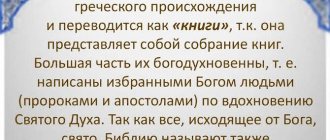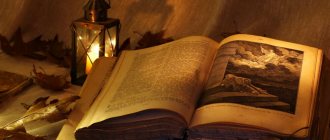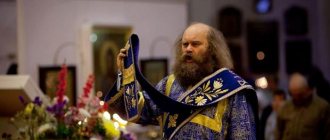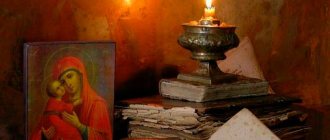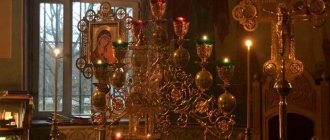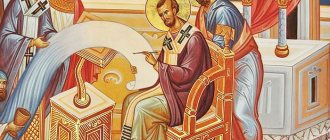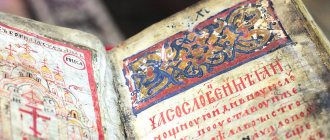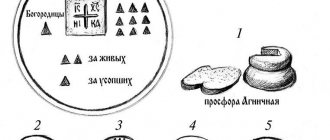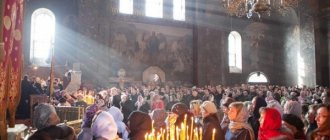About worship and the church calendar.
9.1. What is worship? The divine service of the Orthodox Church is serving God through readings of prayers, chants, sermons and sacred rites performed according to the Charter of the Church. 9.2. Why are services held? Worship, as the external side of religion, serves as a means for Christians to express their religious inner faith and reverent feelings for God, a means of mysterious communication with God. 9.3. What is the purpose of worship? The purpose of the divine service established by the Orthodox Church is to give Christians the best way to express petitions, thanksgivings and praises addressed to the Lord; teach and educate believers in the truths of the Orthodox faith and the rules of Christian piety; to introduce believers into mysterious communion with the Lord and impart to them the grace-filled gifts of the Holy Spirit.
9.4. What do Orthodox services mean by their names?
Liturgy (common cause, public service) is the main service during which Communion (Communion) of believers takes place. The remaining eight services are preparatory prayers for the Liturgy.
Vespers is a service performed at the end of the day, in the evening.
Compline is a service after supper (dinner).
The Midnight Office is a service intended to take place at midnight.
Matins is a service performed in the morning, before sunrise.
Services of the Hours - remembrance of the events (by the hour) of Good Friday (the suffering and death of the Savior), His Resurrection and the Descent of the Holy Spirit on the Apostles.
On the eve of major holidays and Sundays, an evening service is performed, which is called the all-night vigil, because among the ancient Christians it lasted all night. The word "vigil" means "to be awake." The All-Night Vigil consists of Vespers, Matins and the first hour. In modern churches, the all-night vigil is most often celebrated in the evening before Sundays and holidays.
9.5. What services are performed in the Church daily?
– In the name of the Most Holy Trinity, the Orthodox Church performs evening, morning and afternoon services in churches every day. In turn, each of these three services is composed of three parts:
Evening service - from the ninth hour, Vespers, Compline.
Morning - from the Midnight Office, Matins, the first hour.
Daytime - from the third hour, sixth hour, Divine Liturgy .
Daily cycle of Orthodox worship
Thus, nine services are formed from the evening, morning and afternoon church services.
Due to the weakness of modern Christians, such statutory services are performed only in some monasteries (for example, in the Spaso-Preobrazhensky Valaam Monastery). In most parish churches, services are held only in the morning and evening, with some reductions.
9.6. What is depicted in the Liturgy?
– In the Liturgy, under external rites, the entire earthly life of the Lord Jesus Christ is depicted: His birth, teaching, deeds, suffering, death, burial, Resurrection and Ascension to heaven.
9.7. What is called mass?
– People call the Liturgy mass. The name “mass” comes from the custom of ancient Christians, after the end of the Liturgy, to consume the remains of the brought bread and wine at a common meal (or public lunch), which took place in one of the parts of the church.
9.8. What is called a lunch lady?
– Sequence of figurative (obednitsa) – this is the name of a short service that is performed instead of the Liturgy, when the Liturgy is not supposed to be served (for example, during Lent) or when it is impossible to serve it (there is no priest, antimension, prosphora). The Obednik serves as some image or likeness of the Liturgy, its composition is similar to the Liturgy of the Catechumens and its main parts correspond to the parts of the Liturgy, with the exception of the celebration of the Sacraments. There is no communion during mass.
9.9. Where can I find out about the schedule of services in the temple?
– The schedule of services is usually posted on the doors of the temple.
9.10. Why is there not censing of the church at every service?
– The presence of the temple and its worshipers occurs at every service. The liturgical censing can be full, when it covers the entire church, and small, when the altar, iconostasis and the people standing in the pulpit are censed.
9.11. Why is there censing in the temple?
– Incense lifts the mind to the throne of God, where it is sent with the prayers of believers. In all centuries and among all peoples, the burning of incense was considered the best, purest material sacrifice to God, and of all the types of material sacrifice accepted in natural religions, the Christian Church retained only this and a few more (oil, wine, bread). And in appearance, nothing resembles the gracious breath of the Holy Spirit more than the smoke of incense. Filled with such high symbolism, incense greatly contributes to the prayerful mood of believers and with its purely bodily effect on a person. Incense has an elevating, stimulating effect on the mood. For this purpose, the charter, for example, before the Easter vigil prescribes not just incense, but an extraordinary filling of the temple with the smell from the placed vessels with incense.
9.12. Why do priests serve in vestments of different colors?
– Groups of church holidays are assigned a certain color of clergy vestments. Each of the seven colors of liturgical vestments corresponds to the spiritual significance of the event in honor of which the service is being performed. There are no developed dogmatic institutions in this area, but the Church has an unwritten tradition that assigns a certain symbolism to the various colors used in worship.
9.13. What do the different colors of priestly vestments represent?
On holidays dedicated to the Lord Jesus Christ, as well as on the days of remembrance of His special anointed ones (prophets, apostles and saints), the color of the royal vestment is gold.
in golden robes on Sundays - the days of the Lord, the King of Glory.
On holidays in honor of the Most Holy Theotokos and angelic powers, as well as on days of remembrance of holy virgins and virgins, the color of the vestment is blue or white, symbolizing special purity and innocence.
The color purple is adopted on the Feasts of the Holy Cross. It combines red (symbolizing the color of the blood of Christ and the Resurrection) and blue, reminiscent of the fact that the Cross opened the way to heaven.
Dark red is the color of blood. Services in red vestments are held in honor of the holy martyrs who shed their blood for the faith of Christ.
in green vestments , since green is a symbol of life. Divine services in honor of the saints are also performed in green vestments: the monastic feat revives a person by union with Christ, renews his entire nature and leads to eternal life.
in black vestments on weekdays during Lent . Black color is a symbol of renunciation of worldly vanity, crying and repentance.
White color as a symbol of Divine uncreated light is accepted on the holidays of the Nativity of Christ, Epiphany (Baptism), Ascension and Transfiguration of the Lord. Easter Matins also begins in white vestments - as a sign of the Divine light shining from the Tomb of the Risen Savior. White vestments are also used for Baptisms and burials.
From Easter to the Feast of the Ascension, all services are performed in red vestments, symbolizing the inexpressible fiery love of God for the human race, the victory of the Risen Lord Jesus Christ.
9.14. What do candlesticks with two or three candles mean?
- These are dikiriy and trikiriy. Dikiriy is a candlestick with two candles, symbolizing the two natures in Jesus Christ: Divine and human. Trikirium - a candlestick with three candles, symbolizing faith in the Holy Trinity.
9.15. Why is there sometimes a cross decorated with flowers on the lectern in the center of the temple instead of an icon?
– This happens during the Week of the Cross during Great Lent. The cross is taken out and placed on a lectern in the center of the temple, so that, with a reminder of the suffering and death of the Lord, to inspire and strengthen those who are fasting to continue the feat of fasting.
On the holidays of the Exaltation of the Cross of the Lord and the Origin (Demolition) of the Honest Trees of the Life-Giving Cross of the Lord, the Cross is also brought to the center of the temple.
9.16. Why does the deacon stand with his back to the worshipers in the church?
– He stands facing the altar, in which is the Throne of God and the Lord Himself is invisibly present. The deacon, as it were, leads the worshipers and on their behalf pronounces prayer requests to God.
9.17. Who are the catechumens who are called to leave the temple during worship?
– These are people who are not baptized, but who are preparing to receive the Sacrament of Holy Baptism. They cannot participate in church Sacraments, therefore, before the start of the most important church Sacrament - Communion - they are called upon to leave the temple.
9.18. What date does Maslenitsa start from?
– Maslenitsa is the last week before the start of Lent. It ends with Forgiveness Sunday.
9.19. Until what time is the prayer of Ephraim the Syrian read?
– The prayer of Ephraim the Syrian is read until Wednesday of Holy Week.
9.20. When is the Shroud taken away?
– The Shroud is taken to the altar before the Easter service on Saturday evening.
9.21. When can you venerate the Shroud?
– You can venerate the Shroud from the middle of Good Friday until the start of the Easter service.
9.22. Does Communion happen on Good Friday?
- No. Since the Liturgy is not served on Good Friday, because on this day the Lord Himself sacrificed Himself.
9.23. Does Communion happen on Holy Saturday or Easter?
– On Holy Saturday and Easter, the Liturgy is served, therefore, there is Communion of the faithful.
9.24. Until what hour does the Easter service last?
– In different churches the end time of the Easter service is different, but most often it happens from 3 to 6 o’clock in the morning.
9.25. Why aren’t the Royal Doors open throughout the entire service on Easter Week during the Liturgy?
– Some priests are awarded the right to serve the Liturgy with the Royal Doors open.
9.26. On what days does the Liturgy of St. Basil the Great take place?
– The Liturgy of Basil the Great is celebrated only 10 times a year: on the eve of the holidays of the Nativity of Christ and the Epiphany of the Lord (or on the days of these holidays if they fall on Sunday or Monday), January 1/14 - on the day of remembrance of St. Basil the Great, on five Sundays Lent (Palm Sunday is excluded), Maundy Thursday and Great Saturday of Holy Week. The Liturgy of Basil the Great differs from the Liturgy of John Chrysostom in some prayers, their longer duration and longer choir singing, which is why it is served a little longer.
9.27. Why don’t they translate the service into Russian to make it more understandable?
– The Slavic language is a blessed, spiritualized language that the holy church people Cyril and Methodius created specifically for worship. People have become unaccustomed to the Church Slavonic language, and some simply do not want to understand it. But if you go to Church regularly, and not just occasionally, then the grace of God will touch the heart, and all the words of this pure, spirit-bearing language will become understandable. The Church Slavonic language, due to its imagery, precision in the expression of thought, artistic brightness and beauty, is much more suitable for communication with God than the modern crippled spoken Russian language.
But the main reason for the incomprehensibility is not the Church Slavonic language, it is very close to Russian - in order to fully perceive it, you need to learn only a few dozen words. The fact is that even if the entire service were translated into Russian, people would still not understand anything about it. The fact that people do not perceive worship is a language problem to the least extent; in the first place is ignorance of the Bible. Most of the chants are highly poetic renditions of biblical stories; Without knowing the source, it is impossible to understand them, no matter what language they are sung in. Therefore, anyone who wants to understand Orthodox worship must, first of all, begin by reading and studying the Holy Scriptures, and it is quite accessible in Russian.
9.28. Why do the lights and candles sometimes go out in the church during services?
– At Matins, during the reading of the Six Psalms, candles in churches are extinguished, except for a few. The Six Psalms is the cry of a repentant sinner before Christ the Savior who came to earth. The lack of illumination, on the one hand, helps to think about what is being read, on the other hand, it reminds us of the gloom of the sinful state depicted by the psalms, and of the fact that external light does not suit a sinner. By arranging this reading in this way, the Church wants to incite believers to deepen themselves, so that, having entered into themselves, they enter into a conversation with the merciful Lord, who does not want the death of a sinner (Ezek. 33:11), about the most necessary matter - the salvation of the soul through bringing it into line with Him. , Savior, relationships broken by sin. The reading of the first half of the Six Psalms expresses the sorrow of a soul that has moved away from God and is seeking Him. Reading the second half of the Six Psalms reveals the state of a repentant soul reconciled with God.
9.29. What psalms are included in the Six Psalms and why these particular ones?
– The first part of Matins opens with a system of psalms known as six psalms. The sixth psalm includes: Psalm 3 “Lord, who has multiplied all this,” Psalm 37 “Lord, let me not be angry,” Psalm 62 “O God, my God, I come to You in the morning,” Psalm 87 “O Lord God of my salvation,” Psalm 102 “Bless my soul the Lord,” Psalm 142 “Lord, hear my prayer.” The psalms were chosen, probably not without intention, from different places in the Psalter evenly; this is how they represent it all. The psalms were chosen to be of the same content and tone that prevails in the Psalter; namely, they all depict the persecution of the righteous by enemies and his firm hope in God, only growing from the increase of persecution and in the end reaching jubilant peace in God (Psalm 103). All these psalms are inscribed with the name of David, excluding 87, which is the “sons of Korah,” and were sung by him, of course, during persecution by Saul (maybe Psalm 62) or Absalom (Psalms 3; 142), reflecting the spiritual growth of the singer in these disasters. Of the many psalms of similar content, these are chosen here because in some places they refer to night and morning (Ps. 3:6: “I fell asleep and arose, I arose”; Ps. 37:7: “I walked lamenting all day long”) ", v. 14: "I have taught the flattering all day long"; ps. 62:1: "I will pray to You in the morning", v. 7: "I have commemorated You on my bed, in the morning I have learned from You"; ps. 87:2: " I cried out to You in the days and in the night,” v. 10: “All day long I lifted up my hands to You,” v. 13, 14: “Thy wonders will be known in the dark... and I have cried out to You, O Lord, and morning prayer mine will precede Thee"; Ps. 102:15: "His days are like a field flower"; Ps. 142:8: "I hear that in the morning show Thy mercy to me"). Psalms of repentance alternate with thanksgiving.
to the Six Psalms in mp3 format
9.30. What is "polyeleos"?
– Polyeleos is the name given to the most solemn part of Matins – a divine service that takes place in the morning or evening; Polyeleos is served only at festive matins. This is determined by the liturgical regulations. On the eve of Sunday or a holiday, Matins is part of the all-night vigil and is served in the evening.
Polyeleos begins after reading the kathisma (Psalter) with the singing of verses of praise from the psalms: 134 - “Praise the name of the Lord” and 135 - “Confess the Lord” and ends with the reading of the Gospel. In ancient times, when the first words of this hymn “Praise the name of the Lord” were heard after the kathismas, numerous lamps (unction lamps) were lit in the temple. Therefore, this part of the all-night vigil is called “many oils” or, in Greek, polyeleos (“poly” - many, “oil” - oil). The Royal Doors open, and the priest, preceded by a deacon holding a lighted candle, burns incense to the altar and the entire altar, iconostasis, choir, worshipers and the entire temple. The open Royal Doors symbolize the open Holy Sepulcher, from where the kingdom of eternal life shines. After reading the Gospel, everyone present at the service approaches the icon of the holiday and venerates it. In memory of the fraternal meal of ancient Christians, which was accompanied by anointing with fragrant oil, the priest draws the sign of the cross on the forehead of everyone approaching the icon. This custom is called anointing. Anointing with oil serves as an external sign of participation in the grace and spiritual joy of the holiday, participation in the Church. Anointing with consecrated oil on polyeleos is not a sacrament; it is a rite that only symbolizes the invocation of God's mercy and blessing.
9.31. What is "lithium"?
– Litiya translated from Greek means fervent prayer. The current charter recognizes four types of litia, which, according to the degree of solemnity, can be arranged in the following order: a) “lithia outside the monastery,” scheduled for some twelfth holidays and on Bright Week before the Liturgy; b) lithium at Great Vespers, connected with the vigil; c) litia at the end of the festive and Sunday matins; d) lithium for the repose after weekday Vespers and Matins. In terms of the content of the prayers and the rite, these types of litia are very different from each other, but what they have in common is the departure from the temple. In the first type (of those listed), this outflow is complete, and in the others it is incomplete. But here and here it is performed in order to express the prayer not only in words, but also in movement, to change its place to revive prayerful attention; The further purpose of the lithium is to express - by removing from the temple - our unworthiness to pray in it: we pray, standing before the gates of the holy temple, as if before the gates of heaven, like Adam, the publican, the prodigal son. Hence the somewhat repentant and mournful nature of lithium prayers. Finally, in litia, the Church emerges from its blessed environment into the outside world or into the vestibule, as a part of the temple in contact with this world, open to everyone not accepted into the Church or excluded from it, for the purpose of a prayer mission in this world. Hence the national and universal character (for the whole world) of lithium prayers.
9.32. What is the Procession of the Cross and when does it happen?
– A procession of the cross is a solemn procession of clergy and lay believers with icons, banners and other shrines. Processions of the cross are held on annual special days established for them: on the Holy Resurrection of Christ - the Easter Procession of the Cross; on the feast of Epiphany for the great consecration of water in memory of the Baptism of the Lord Jesus Christ in the waters of the Jordan, as well as in honor of shrines and great church or state events. There are also extraordinary religious processions established by the Church on especially important occasions.
9.33. Where did the Processions of the Cross come from?
– Just like holy icons, religious processions got their origins from the Old Testament. The ancient righteous often performed solemn and popular processions with singing, trumpeting and rejoicing. Stories about this are set out in the sacred books of the Old Testament: Exodus, Numbers, the books of Kings, Psalms and others.
The first prototypes of the religious processions were: the journey of the sons of Israel from Egypt to the promised land; the procession of all Israel following the ark of God, from which the miraculous division of the Jordan River occurred (Joshua 3:14-17); the solemn seven-fold circumambulation of the ark around the walls of Jericho, during which the miraculous fall of the impregnable walls of Jericho took place from the voice of the sacred trumpets and the proclamations of the entire people (Joshua 6:5-19); as well as the solemn nationwide transfer of the ark of the Lord by kings David and Solomon (2 Kings 6:1-18; 3 Kings 8:1-21).
9.34. What does the Easter Procession mean?
– The Holy Resurrection of Christ is celebrated with special solemnity. The Easter service begins on Holy Saturday, late in the evening. At Matins, after the Midnight Office, the Easter Procession of the Cross takes place - worshipers, led by the clergy, leave the temple to make a solemn procession around the temple. Like the myrrh-bearing women who met the risen Christ the Savior outside Jerusalem, Christians meet the news of the coming of the Holy Resurrection of Christ outside the walls of the temple - they seem to be marching towards the risen Savior.
The Easter procession takes place with candles, banners, censers and the icon of the Resurrection of Christ under the continuous ringing of bells. Before entering the temple, the solemn Easter procession stops at the door and enters the temple only after the jubilant message has been sounded three times: “Christ is risen from the dead, trampling down death by death and giving life to those in the tombs!” The procession of the cross enters the temple, just as the myrrh-bearing women came to Jerusalem with joyful news to the disciples of Christ about the risen Lord.
9.35. How many times does the Easter Procession happen?
– The first Easter religious procession takes place on Easter night. Then, during the week (Bright Week), every day after the end of the Liturgy, the Easter Procession of the Cross is held, and before the Feast of the Ascension of the Lord, the same Processions of the Cross are held every Sunday.
9.36. What does the Procession with the Shroud on Holy Week mean?
– This mournful and deplorable procession of the Cross takes place in remembrance of the burial of Jesus Christ, when His secret disciples Joseph and Nicodemus, accompanied by the Mother of God and the myrrh-bearing women, carried in their arms the deceased Jesus Christ on the cross. They walked from Mount Golgotha to Joseph’s vineyard, where there was a burial cave in which, according to Jewish custom, they laid the body of Christ. In memory of this sacred event - the burial of Jesus Christ - a procession with the Shroud is held, which represents the body of the deceased Jesus Christ, as it was taken down from the cross and laid in the tomb.
The Apostle says to believers: “Remember my bonds” (Col. 4:18). If the Apostle commands Christians to remember his sufferings in chains, then how much more strongly should they remember the sufferings of Christ. During the suffering and death on the cross of the Lord Jesus Christ, modern Christians did not live and did not share sorrow with the apostles, therefore in the days of Holy Week they remember their sorrows and lamentations about the Redeemer.
Anyone called a Christian who celebrates the sorrowful moments of the Savior’s suffering and death cannot help but be a participant in the heavenly joy of His Resurrection, for in the words of the Apostle: “We are joint heirs with Christ, if only we suffer with Him, so that we may also be glorified with Him” (Rom. 8). :17).
9.37. On what emergency occasions are religious processions held?
– Extraordinary processions of the Cross are carried out with the permission of the diocesan church authorities on occasions that are especially vital for the parish, the diocese or the entire Orthodox people - during an invasion of foreigners, during the attack of a destructive disease, during famine, drought or other disasters.
9.38. What do the banners with which religious processions take place mean?
– The first prototype of banners was after the Flood. God, appearing to Noah during his sacrifice, showed a rainbow in the clouds and called it “a sign of the everlasting covenant” between God and people (Gen. 9:13-16). Just as a rainbow in the sky reminds people of God’s covenant, so on banners the image of the Savior serves as a constant reminder of the deliverance of the human race at the Last Judgment from the spiritual fiery flood.
The second prototype of the banners was during Israel's exit from Egypt during the passage through the Red Sea. Then the Lord appeared in a pillar of cloud and covered all the army of Pharaoh with darkness from this cloud, and destroyed it in the sea, but saved Israel. So on the banners the image of the Savior is visible as a cloud that appeared from heaven to defeat the enemy - the spiritual Pharaoh - the devil with all his army. The Lord always wins and drives away the power of the enemy.
The third type of banners was the same cloud that covered the tabernacle and overshadowed Israel during the journey to the Promised Land. All Israel looked at the sacred cloud cover and with spiritual eyes understood in it the presence of God Himself.
Another prototype of the banner is the copper serpent, which was erected by Moses at the command of God in the desert. When looking at him, the Jews received healing from God, since the copper serpent represented the Cross of Christ (John 3:14,15). So, while carrying banners during the procession of the Cross, believers raise their bodily eyes to the images of the Savior, the Mother of God and the saints; with spiritual eyes they ascend to their prototypes existing in heaven and receive spiritual and physical healing from the sinful remorse of spiritual serpents - demons who tempt all people.
A practical guide to parish counseling. St. Petersburg 2009.
Types of services
All services, as already mentioned, are divided into 3 types. Much of their implementation is borrowed from Old Testament times.
What is evening service
What time does the evening service in church start? The beginning of the day is considered not midnight, but 6 pm. Therefore, the first service is evening. The main theme of this service is memories of the events of the Sacred History of the Old Testament: the creation of the world by the Lord, the original sin of our ancestors, the ministry of the prophets and the legislation of Moses. Christians also thank the Lord for the day they have lived.
After Vespers, it is customary to hold Compline. Often these are public prayers for the coming sleep. They recall the descent of Christ into hell and the rescue of the righteous from the power of the devil.
At midnight they serve the Midnight Office. During this service, they are reminded of the Second Coming of Christ and the Last Judgment.
What is called morning
After the evening service, the morning service takes place. The longest service is called the morning service. It is usually held before sunrise. During the ceremony, it is customary to remember the events of Christ’s earthly life. A large number of both repentance and thanksgiving prayers are also read.
It is advisable to check with the church you are visiting about what time the morning service in the church begins. The start time may differ, but not significantly.
Around 7 o'clock in the morning a service is held, which is called the 1st hour. This is a short service. During which they talk about Christ's presence at the court of the high priest.
The 3rd hour is spent around 9 o'clock. During its implementation, they remember the events that took place in the Upper Room of Zion, where the Holy Spirit was sent to the apostles, and the Savior was sentenced to death by the praetorian Pilate.
The best article for you, go to: What clothes are men buried in?
At noon the 6th hour is served. This is the time when they talk about the crucifixion of Jesus.
At three o'clock in the afternoon the 9th hour is spent. This period falls on the remembrance of Christ's death on the cross.
